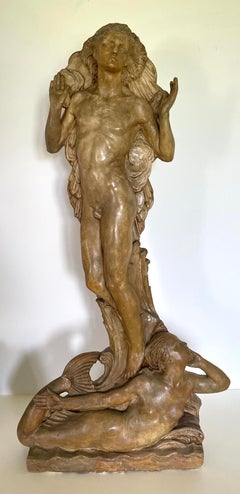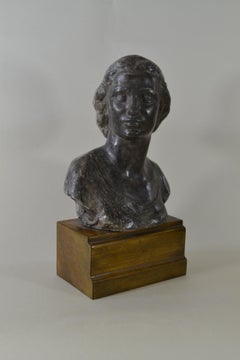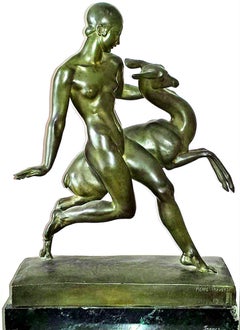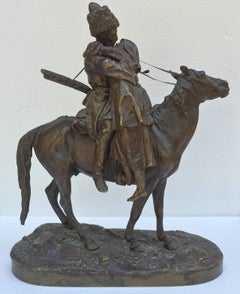Richard Garbe Art
to
3
1
1
1
Overall Height
to
Overall Width
to
2
3
3
3
2
1
1
1
1
3
1
1
3
6,826
3,114
2,517
1,217
3
Artist: Richard Garbe
Richard Garbe - Helios - Early 20th Century British patinated plaster sculpture
By Richard Garbe
Located in London, GB
RICHARD LOUIS GARBE, RA
(1876-1957)
Helios
Signed and dated 1929
Plaster with patinated surface
86 cm., 33 ¾ in. high
Garbe was born in Dalston, London, the son of Gustave Garbe,...
Category
Early 20th Century Art Deco Richard Garbe Art
Materials
Plaster
The Falconer, Art Deco British Plaster Sculpture by Richard Garbe RA
By Richard Garbe
Located in London, GB
RICHARD GARBE, RA
(1876-1957)
The Falconer
Signed and dated on the reverse: Richard Garbe, ARA / 1932
Patinated plaster
49.5 cm., 19 ½ in. high
Proven...
Category
1930s Art Deco Richard Garbe Art
Materials
Plaster
Alfreda, The Artist's Daughter - British 1950s plaster bust by Richard Garbe
By Richard Garbe
Located in London, GB
RICHARD LOUIS GARBE, RA
(1876-1957)
Alfreda, The Artist’s Daughter
Signed and dated 1956
Plaster with patinated surface on a wooden base
30 cm., 11 ¾ in. high
Provenance:
Gifted ...
Category
1950s Realist Richard Garbe Art
Materials
Plaster
Related Items
Art Deco Bronze Nude Girl with Fawn, Amazon with Fawn
By Pierre Traverse
Located in Miami, FL
Signed on base. This was exhibited at the Goldscheider Pavilion at the 1925 Paris Exhibition
Marble base has loss to right edge and very small lose to center edge. , Bronze is in ve...
Category
1920s Art Deco Richard Garbe Art
Materials
Bronze
"The Farewell Kiss"
By Evgeny Lanceray
Located in Southampton, NY
This is a beautiful original bronze casting by the foremost Russian sculptor of his day Evgeny Lanceray. Artist signed on the base in Cyrillic (image 5) and is also inscribed on the ...
Category
Late 19th Century Realist Richard Garbe Art
Materials
Bronze
Vincent Glinsky Alabaster Reclining Nude Sculpture c.1950
Located in San Francisco, CA
Vincent Glinsky Alabaster Reclining Nude Sculpture c.1950
9" long x 4.5" deep x 7.5" high
Signed at the base
Good vintage condition
Vincent Glins...
Category
Mid-20th Century Art Deco Richard Garbe Art
Materials
Alabaster
H 7.5 in W 9 in D 4.5 in
2 Sculptures: "The Power" & "The Glory" WPA Depression WWII era mid 20th century
By Agnes Yarnall
Located in New York, NY
2 Sculptures: "The Power" & "The Glory" WPA Depression WWII era mid 20th century by Agnes Yarnall circa 1940s.
Sculptor, painter, poet and artistic historian, Agnes Yarnall has, since the age of six been breathing life into her art.
Renowned as a sculptor, whose commissioned portrayals of contemporary celebrities are prized. She has sculpted Judith Anderson, Edna St. Vincent Millay, Carl Sandburg...
Category
1940s American Modern Richard Garbe Art
Materials
Plaster
Large George Aarons Terracotta Sculpture Relief Art Deco Plaque WPA Artist
By George Aarons
Located in Surfside, FL
Two Figures (Mother and son)
9" x 17" terracotta sculpture, signed lower left mounted to wood panel, 15 1/2" x 23 1/2"
George Aarons (born Gregory Podubisky, in St. Petersburg, Russ...
Category
20th Century Art Deco Richard Garbe Art
Materials
Wood, Terracotta
Stephanie Todhunter, Ellie, Mixed Media, 2019
Located in Boston, MA
Artist: Stephanie Todhunter
Title: Ellie
Year: 2019
Size: 8.5"x7"x4"
Material: Plaster of Paris found objects, Spray Paint, alcohol inks
Each piec...
Category
2010s Contemporary Richard Garbe Art
Materials
Plaster, Found Objects, Ink
Industrial Machine Age American Scene WPA Mid 20th Century 1939 SF World's Fair
Located in New York, NY
Industrial Machine Age American Scene WPA Mid 20th Century 1939 SF World's Fair
HAIG PATIGIAN (American/Armenian, 1876-1950)
Aeronautics Pediments
Two Plaster Casts, c. 1930s
each 13.25 x 14.75 x 6 inches
It's possible these moquettes were created for the 1939 World's Fair, the Golden Gate International Exhibition in San Francisco.
Provenance: Private Collection of Lois M. Wright, Author of "A Catalogue of the Life Works of Haig Patigian, San Francisco Sculptor, 1876-1950),” 1967
Loan to Oakland Museum of California (Oakland, CA)
BIO
Haig Patigian is noted for his classical works, which are especially numerous in public venues in San Francisco, California. Patigian was born in Van, Armenia, which at that time was under Turkish rule. Haig was the son of Avedis and Marine Patigian, both teachers in the American Mission School there. He and his older brother showed an aptitude for art early on and were encouraged by their parents. Their father himself had taken up the new hobby of photography. The 1880s were harsh times, however, for many Armenians under an oppressive rule by the Turkish government. Many people were fleeing to the safety of the United States. Suspicious Turkish authorities accused his father of photographing city structures for the Russian government, and in 1888 he fled for his life to America.
Haigs father made his way to Fresno, California, and began life anew as a ranch hand. Within two years he sent for his wife, as well as Haig, his three sisters and brother, and in 1891 the Patigians made the journey from Armenia. Haigs father, an industrious man, worked on various farms, and eventually bought his own ranch and vineyard. It was among fertile farmland of Fresno that Haig grew up.
Young Haigs education consisted of teachings by his parents and by intermittent attendance in public schools. Although he had dreams of becoming an artist, he did not have the opportunity for formal study of art, and began working long days in the vineyards around Fresno.
At age seventeen, Haig made a step towards his dreams and apprenticed himself to learn the trade of sign painting. In his spare time he nurtured his interest in art by painting nature and life scenes with watercolors and oil paints. When his sign-painting mentor left Fresno, Haig opened his own shop and made a name for himself in the town. San Francisco, in the meantime, had been attracting artists since the Gold Rush and had become a thriving art center. Within a few years, Haig had put aside several hundred dollars to move to San Francisco, joining his brother who was already working there as an illustrator.
In 1899, when he was twenty-three, Haig had saved enough money to enroll at the Mark Hopkins Art Institute in San Francisco. Like many aspiring artists of his time, Patigian supported himself by working as a staff artist in the art department of a local newspaper, and in the winter of 1900, nearing his 24th birthday, Haig began work for the San Francisco Bulletin, producing cartoons, black and white illustrations, as well as watercolors.
In 1902 tragedy struck Haig and his family. His 29-year-old brother died of pneumonia, and then his frail mother died a short time later. Five months more saw his youngest sister, just out of high school, die too. Saddened and depressed, Haig moved out of the studio he had shared with his brother, and into a dilapidated studio in a poor section of town. During this time of sadness, Haig fed a growing interest in sculpture.
In 1904 Haig created what he later called his "first finished piece in sculpture". The work, called "The Unquiet Soul", depicted a man thrown back against a rock while waves lash at his feet. The body was tense and twisted, with one hand, in Haig's own words, "searchingly leaning and clutching the rock, while the other masks his troubled head".
The Press Club of San Francisco, which Haig had joined in 1901, put "The Unquiet Soul" on exhibition and local headlines proclaimed "Local Newspaper Artist Embraces Sculptor's Art", and "First Work Predicts Brilliant Future". With the support of friends and community acclaim, the young illustrator left his newspaper job and became a professional sculptor.
The path of his new career was not easy though. Haig had never made much money working for the newspaper and his father needed help with growing debt from funeral expenses and business problems. From time to time Haig sold some artwork, but also occasionally borrowed from friends to pay the rent. He was the classic 'starving artist'.
In the spring of 1905 a white-bearded 81-year-old stranger knocked on Haig's door. It was George Zehndner, from Arcata, California. Zehndner had been born in Bavaria, Germany in 1824, the son of a farmer. In 1849 he had come to America looking for prosperity, settling in Indiana, where he worked on a farm and learned English. He found his way to the West Coast in 1852. Penniless, he worked in various jobs from San Francisco to Sacramento, then found some luck working in the gold fields of Weaverville in Trinity County, and eventually moving to a farm on 188 acres near Arcata. In his 77th year in May of 1901, Zahndner had taken a trip to San Jose, where he stood in a crowd to see a man he thought much of, President William McKinley. McKinley was popular as 'the first modern president' partially because he realized going out to meet the common person increased his support. In September of that year, however, an anarchist assassinated the president while he stood in a receiving line at the Pan-American Exhibition in Buffalo, New York. Soon after, the city of San Jose erected a statue of the slain president in St. James Park. Zehndner took a second trip to San Jose where he visited the McKinley monument. Touched, Zehndner decided that, no matter the cost, his town of Arcata too would memorialize McKinley.
George Zehndner had read about Haig in a newspaper article and asked if Patigian would create a heroic statue of the late President McKinley for Arcata. When asked how much it would cost, Haig responded, despite his borderline poverty, with the fabulous sum of $15,000. Zehndner agreed. The President was to be portrayed standing, wearing an overcoat, with his feet planted squarely on the ground. In the finished statue, one hand is held out before him in a typical posture of speaking, with the other hand holding the speech as his side. The 9-foot statue...
Category
1930s American Modern Richard Garbe Art
Materials
Plaster
Daniel Arsham FUTURE RELIC 07 CASSETTE PLAYER Limited Sculpture Sony Walkman 90s
By Daniel Arsham
Located in Madrid, Madrid
Daniel Arsham - FUTURE RELIC 07 - CASSETTE PLAYER
Date of creation: 2017
Medium: Plaster and crushed glass
Edition number: 476/500
Size: 12.7 × 14.6 × 14 cm
Condition: In mint condi...
Category
2010s Modern Richard Garbe Art
Materials
Glass, Plaster
Free Shipping
H 5.75 in W 5.75 in D 5.08 in
Leda and the Swan modernist mid century sculpture by French woman artist
Located in Norwich, GB
A unique piece: a hand modelled sculpture by French artist Jeannine Nathan (b.1924). Working in Paris, Jeannine was able to visit Picasso’s studio, and was impressed by the
Master’s ...
Category
1960s Modern Richard Garbe Art
Materials
Plaster
H 3.55 in W 4.73 in D 9.85 in
"Untitled 1" Sculpture 23" x 13" x 8" inch Edition 1/1 by Isaac Pelayo
By Isaac Pelayo
Located in Culver City, CA
"Untitled 1" Sculpture 23" x 13" x 8" inch Edition 1/1 by Isaac Pelayo
Unique work. Signed by the Artist. Comes with COA.
Hand embellished plaster/fiberg...
Category
21st Century and Contemporary Baroque Richard Garbe Art
Materials
Fiberglass, Plaster, Spray Paint
H 23 in W 13 in D 8 in
Plaster Sculpture Relief Art Deco Plaque WPA Artist Peace Swords to Ploughshares
By George Aarons
Located in Surfside, FL
Size includes wood mounting.
George Aarons (born Gregory Podubisky, in St. Petersburg, Russia, 1896 - died in Gloucester, Massachusetts 1980) was a distinguished sculptor who lived and taught in Gloucester, Massachusetts, for many years until his death in 1980. He had, many students in the area and he designed Gloucester's 350th Anniversary Commemorative Medal.
Aarons moved from Russia to the United States when he was ten. His father was a merchant. He began taking drawing classes during evenings at Dearborn Public School in Boston as a teenager and went on to study at the Boston Museum of Fine Arts in 1916. Aarons later moved to New York City to study with Jo Davidson, and other Paris-trained masters at the Beaux-Arts Institute. He eventually returned to the Boston area and established studios in Brookline and Gloucester, Massachusetts. During his lifetime, he was recognized internationally and won several prestigious awards. Aarons had studios in Brookline, Massachusetts and Gloucester, Massachusetts where he produced large bronze and marble figures and wood carvings. He produced several projects for the Works Progress Administration including a group of three figures for the Public Garden (Boston), a longshoreman, fisherman and foundry worker, as well as a large relief (1938) for the South Boston Housing Project and façade of the Baltimore Hebrew Congregational Building (1956).
His works are at the Museum of Art in Ein Harod, Israel; Fitchburg Art Museum in Massachusetts, Musée de St. Denis in France; Hilles Library at Radcliffe College in Cambridge, Massachusetts; and Hillel House at Boston University in Massachusetts.
He did reliefs for Siefer Hall at Brandeis University in Waltham, Massachusetts (1950); Edward Filene (the founder of Filene's Department Store and a philanthropist) on the Boston Common; Fireman's Memorial in Beverly, Massachusetts; a memorial to Mitchell Frieman in Boston; the U.S. Post Office in Ripley, Mississippi; and at the Cincinnati Telephone Building; the Combined Jewish Philanthropies building in Boston (1965); and a commemorative medal for the 350th Anniversary of the City of Gloucester, Massachusetts (1972).
Characteristic of his era, George Aarons was among the foreign-born American sculptors of the early 20th century who started their careers as academicians and evolved into modernists and increasingly abstract artists.
Over thirty pieces spanning the length of this sculptor's career were featured in this exhibition, including work in various medium bronze, wood and original plasters. Like his contemporaries, Aarons experimented with direct carving in wood, and he was one of the few academically trained sculptors who consistently cut his own works in marble. His early work was classically inspired figurative work, along with sensitive portraits. Some of his most powerful sculpture comes from his middle period, when he worked through his emotional pain following the global realization of the Jewish Holocaust. He depicted humanity deep anxiety over this tragedy with figures that are at once symbolically charged and movingly beautiful. Aarons late work consists of radically simplified forms that continue to reference the human form and often are carved directly in wood and stone.
Aarons summered and taught classes on Cape Ann for many years before moving to Gloucester full-time with his wife about 1950. While Aarons is best known locally for his domestic-scale works, he also executed numerous monumental, public commissions that can be found throughout the United States in cities such as Washington, D.C.; Baltimore, Maryland; and Cincinnati, Ohio; as well as in France and Israel.
As noted in a Gloucester Daily Times Article, Aarons wanted his sculptures to honor the struggles and nobility of people and rail against the evil done against them. And that was why, even as his work grew more and more abstract, stylized and simplified, he never left behind the form of the human figure that had been his focus from his earliest works.
Aarons told the Gloucester Daily Times in September 1954 that he found it hard to remember at just what age he started studying art, but he recalled that the nude model had to partially dress when he was in class because he was so young. He initially studied painting and drawing at the museum school, but he once said he became fascinated by sculpture when he met an established sculptor at the Copley Society in Boston who invited Aarons to his studio and offered him some clay to "play around" with.
After he graduated, he apprenticed under sculptors Richard Brooks, Robert Baker and Solon Borglum. He worked as a carpenter, shipbuilder, dishwasher and chimney sweep. He fashioned architectural decorations, including figures for fountains and now and then a few commissioned portraits. He returned to Boston by the early 1920s and began to exhibit his own works and get commissions for portraits, fountains and reliefs.
His sculptures from this time are dreamy and romantic in the realistic, academic style of the time. A painted portrait of the young Aarons that is included in the North Shore Arts Association exhibit shows a determined fellow with dark brown hair, a suit and bow tie. However, in 1922, this determined young artist was living with his parents on Calder Street in Dorchester.
In the 1930s, Aarons adopted the streamlined, monumental style of the socialist works of the time. Aarons made money, as he would all his life, from commissions, selling his personal work and teaching sculpture, but the Depression of the 1930s was tough for everyone.
So Aarons found work though the federal Works Progress Administration, one of Franklin Roosevelt's New Deal programs. He received his first major commission when he was asked to create a public sculpture for the South Boston Harbor Village public housing project around 1937. He was elevated to the position of supervisor for the project and received a corresponding $5 pay increase to make his weekly salary $32. The raise convinced him he was fit to marry and he proposed to Gertrude Band, an attractive brunette dancer whom he had been dating for more than a year. They were married before the Harbor Village project was dedicated on Labor Day 1938.
Aarons' design featured a brawny, larger-than-lifesize fisherman, longshoreman and a laborer flanked by a boy and girl at either end to portray the children who would live in the apartments. Aarons elected to do the piece in cast stone to employ carpenters and laborers as well as craftsman for a total of 10 men.
In his sculpture, Aarons focused more and more on the theme of oppressed people as he worried about the spread of fascism and Nazism during the 1930s, World War II and after. He had done pieces during the mid-1930s about the oppression of African-Americans, including "Negro Head," which is in the North Shore Art Association retrospective. After the war, he also delved into Jewish themes and became increasingly known as an important Jewish artist, leading to commissions from Jewish organizations across the country and abroad.
"He gets into raw emotion. Some people describe him as an expressionist because of the emotion (in his work)," Reynolds says.
But Aarons, also sculpted sensual sexual nudes...
Category
20th Century Art Deco Richard Garbe Art
Materials
Plaster, Wood
Diana the Huntress, French Art Deco Artemis Bronze Sculpture
Located in Atlanta, GA
This is a stunning French Art Deco bronze sculpture figurine. The statue features a stylized freestyle interpretation of Artemis or Diana the Huntress (Diane Chasseresse). The nude f...
Category
1930s Art Deco Richard Garbe Art
Materials
Bronze
H 11.03 in W 2.96 in D 2.96 in
Richard Garbe art for sale on 1stDibs.
Find a wide variety of authentic Richard Garbe art available for sale on 1stDibs. You can also browse by medium to find art by Richard Garbe in plaster and more. Much of the original work by this artist or collective was created during the 20th century and is mostly associated with the Art Deco style. Not every interior allows for large Richard Garbe art, so small editions measuring 10 inches across are available. Customers who are interested in this artist might also find the work of Christopher Slatoff, Fiona Morley, and Bela Bacsi. Richard Garbe art prices can differ depending upon medium, time period and other attributes. On 1stDibs, the price for these items starts at $2,416 and tops out at $7,008, while the average work can sell for $5,097.




